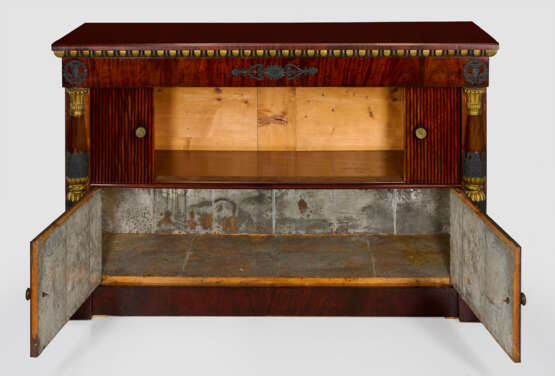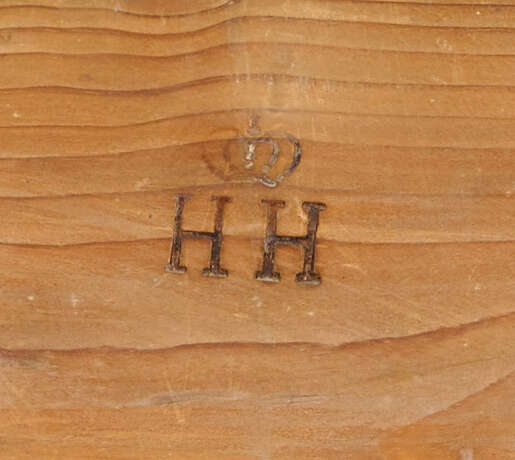ID 1082829
Lot 1408 | Bedeutender Spätempire-Halbschrank,
Estimate value
€ 12 000 – 24 000
Bedeutender Spätempire-Halbschrank, entworfen von Georg Ludwig Friedrich Laves für das königlich-hannoversche Schloss Herrenhausen
Mahagoni, furniert. Stuckierte, schwarz-grau gefasste und teilw. vergoldete Dekorationen sowie Applikationen aus dunkel patiniertem Zink. Gerader, querrechteckig angelegter Korpus auf flachem, gekanteten Zargensockel. In der gegliederten Front breiter Rolloverschluss sowie unterhalb zwei optisch entsprechende Türen, flankiert von eingestellten, mehrfach gegliederten Balusterhälften mit reliefierten Basen und Kapitellen sowie Blattmanschetten Akanthus und Lotus. Innen teilw. originale Auskleidung aus genagelten Zinktafeln. Leicht vorkragender oberer Stirnbereich mit applizierten von Weinreben umkränzten Vasenmotiven bzw. zentrale Rosette mit Palmetten. Gering überstehende Deckplatte mit umlaufendem Fries aus Eierstab. Rückseitig Inv.-Brandstempel HH mit Krone. Beiliegend Kunsthistorische Stellungnahme von Dr. Thomas Dann, Oktober 2013. H. 92 cm. 147 cm x 58,5 cm.
Das Möbel war Bestandteil des Speisesaals, der anlässlich des dreiwöchigen Besuchs Georg IV., König des Vereinigten Königreichs Großbritannien und Irland und König von Hannover 1821 in Schloss Herrenhausen von dem Hofbaumeister Georg Ludwig Friedrich Laves umgestaltet wurde. Die Auskleidung mit Zinkblech lässt hierbei auf eine ursprüngliche Verwendung als Verwahrmöbel für Speisen oder Spirituosen schließen. Laves (1788-1864) zählt neben Karl Friedrich Schinkel und Leo von Klenze zu den bedeutendsten deutschen Architekten des Klassizismus. Das höfische Spätempiremöbel mit seinem hohen, repräsentativen Anspruch, zählt nach Aussagen des Laves-Spezialisten Dr. Thomas Dann "zu dem feinsten, was hannoversche Möbelkunst unter Laves hervorgebracht hat".
Vgl. Abb. eines korrespondierenden Weinkühlers aus derselben Speisesaalausstattung in: Dann 2022, S. 156.
Provenienz: Königliches Haus Hannover, ehemals Inventar Schloss Herrenhausen; Auktion "The Royal House of Hanover/Das Königshaus von Hannover", Sotheby's, Schloss Marienburg, 5.-15.10.2005, Unter zusätzliche Lose: Lot 5653.
A significant mahogany veneered late Empire sideboard designed by Georg Ludwig Friedrich Laves for the Royal House of Hanover.
Hannover. Um 1820.
| Address of auction |
Kunstauktionshaus Schloss Ahlden GmbH Große Str. 1 29691 Ahlden(Aller) Germany | ||||||||||||||
|---|---|---|---|---|---|---|---|---|---|---|---|---|---|---|---|
| Preview |
| ||||||||||||||
| Phone | +49 5164 80100 | ||||||||||||||
| Buyer Premium | 25.0 | ||||||||||||||
| Conditions of purchase | Conditions of purchase | ||||||||||||||
| Business hours | Business hours
|





